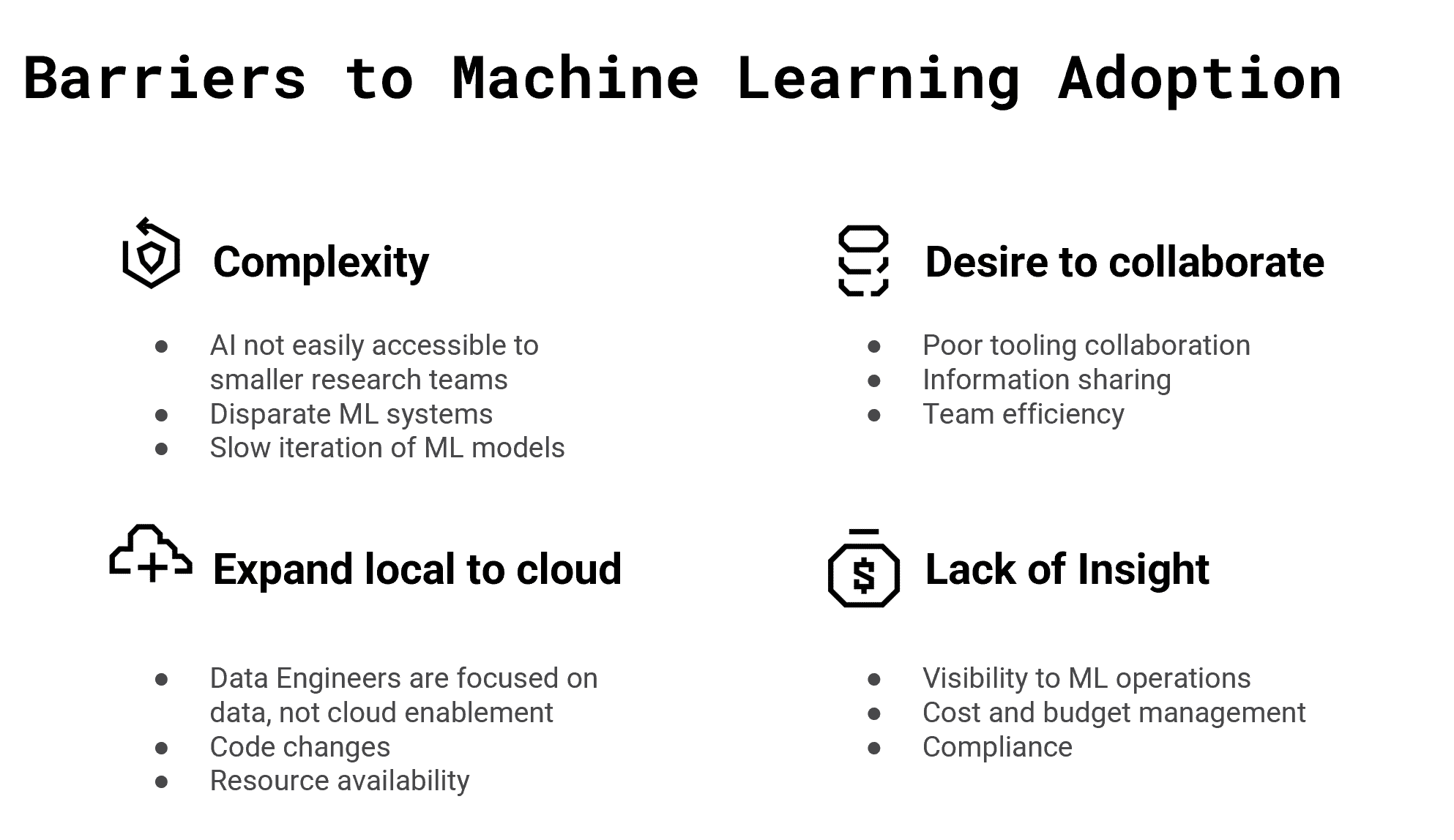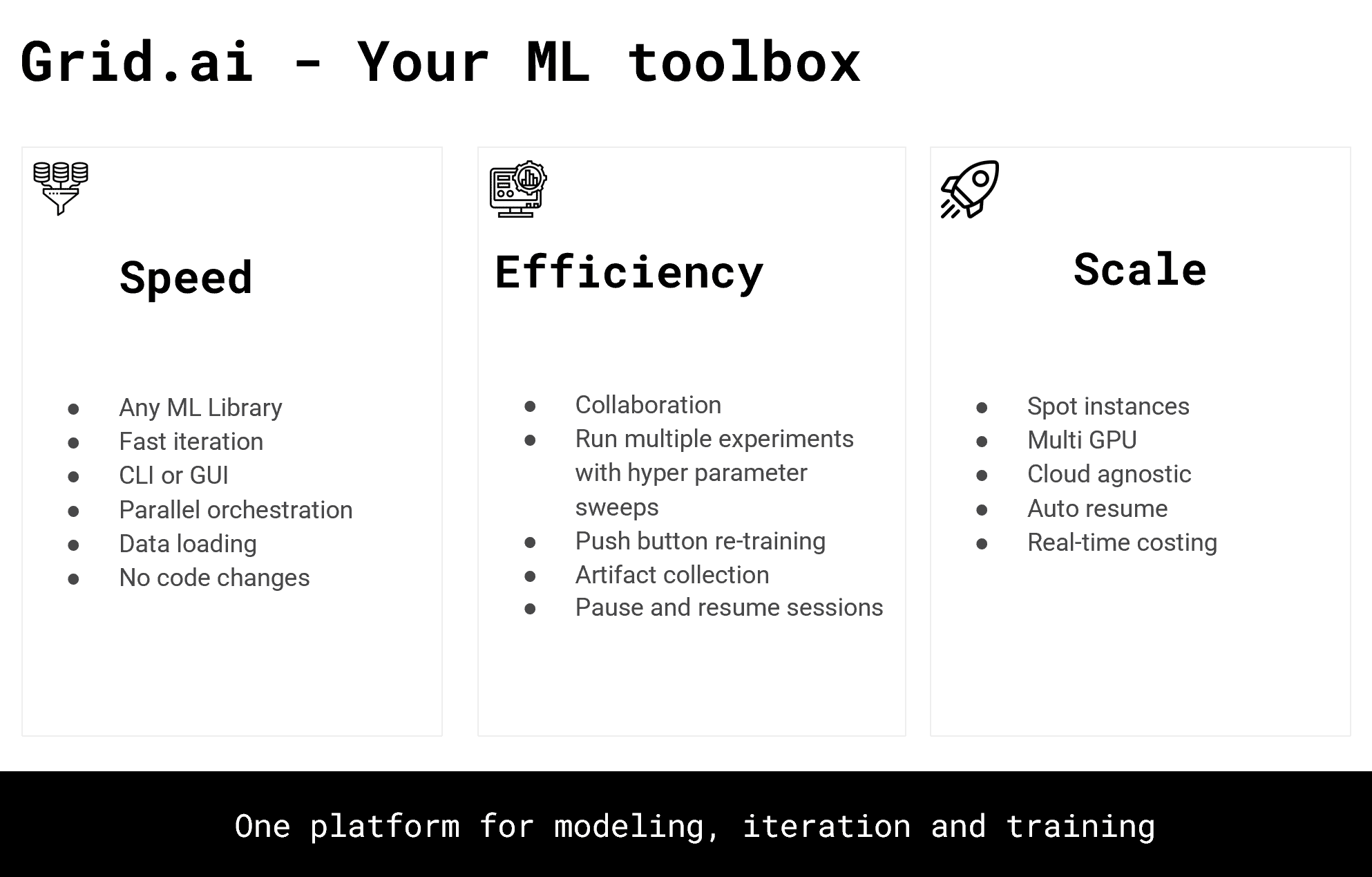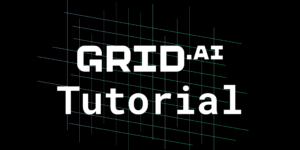The Grid platform enables users to quickly iterate through the model development life cycle by managing the provisioning of machine learning infrastructure on the cloud.
Barriers to Machine Learning Adoption
Machine learning (ML) is a complicated field. This is especially the case when trying to figure out how to build models around your data. This includes:
- making sure you have access to the infrastructure to test and train your models (and the budget to pay for it),
- viewing logs to determine why a model is failing,
- sharing and collaborating with other team members to push your project forward,
- and moving models into production and then using them in the real world.
There are so many places in your pipeline where everything can fall apart. In fact, there are polls that show 80% of all machine learning models never get deployed!

So, where does Grid fit in?
Your Machine Learning Toolbox
Grid fills the holes within your ML infrastructure.
Many of our data scientist customers don’t have the time or resources to hire and train additional MLOps team members, and they also lack access to critical infrastructure. They are generally building on their laptops or desktops, but their system can’t handle extensive training.
To tackle these challenges, they look to the Grid platform to provide a solution that allows them to rapidly prototype and train models, and go to production quickly in order to drive innovative research.

One of Grid’s defining features is that there are no code changes needed when training! This is a huge benefit for data scientists who want to take a model and just push it to the cloud.
Grid makes this process simple: it provides a wide variety of infrastructure options that include CPU or GPU instances to tackle any workload. Datastores are also available to capture all resources from one location, and interactive Grid Sessions give users the dashboard capability in one UI.
Grid works, it scales, and it meets the needs of data scientists, researchers, engineers, and other users focused on bringing machine learning projects to life.
Grid’s Mission
Grid’s goal is to eliminate the burden of managing infrastructure in order to rapidly prototype and train models in an effort to reduce the time spent in the model development lifecycle. Grid meets this goal by maintaining three core pillars:
- Community engagement. We’re always working to build products that solve your problems, and we always encourage users to get in touch with feedback.
- Research and development. We maintain our commitment to excellence leveraging state-of-the-art tools and industry knowledge to make products that empower our users.
- Constant innovation. We build products that are useful both now and in the long term. By vigilantly evaluating customer needs and user experience, Grid delivers innovative features critical to the future of the industry.
Grid Features
Grid’s core features are:
- Datastores. Data storage that is shareable between teams and mountable to both Runs and Sessions.
- Runs. Transient jobs that will run your Python, Julia, or R code and store the resulting artifacts for downloads.
- Sessions. Interactive Jupyter notebook environments capable of running Python, Julia, and R code. This feature is designed for iteration and prototyping with the ability to pause without losing any work.
- Artifact management. Grid offers the ability to manage and download the artifacts created from model training.
As a platform, Grid enables users to scale their workflow and facilitates faster model training.
We do this by being:
- Bigger. Train and scale models using Grid Runs, Sessions and a variety of Cloud-based infrastructure.
- Faster. Quickly develop models with one-click access to scalable compute and the ability to run parallel hyperparameter search.
- Easier. You don’t need to remember thousands of commands from different environments in order to train a model, generate Artifacts, and increase replicability.
“The intangible value of Grid: I am a happier data scientist because I get to focus on the stuff that I love to work on, and ultimately the reasons that they hired me, which is to research and develop models and translate real world problems in podtech into machine learning products. I think it presents a justification for machine learning engineers and data scientists to focus on what we were hired to do, rather than spinning our wheels on infrastructure.” Chase Bosworth, Machine Learning Engineering Manager (Spotify x Podsights)
So, that’s it in a nutshell! Interested in learning more about how Grid can help you manage machine learning model development for your next project? Get started with Grid’s free community tier account (and get $25 in free credits!) by clicking here. Also, explore our documentation and join the Slack community to learn more about what the Grid platform can do for you.
Happy Grid-ing!

